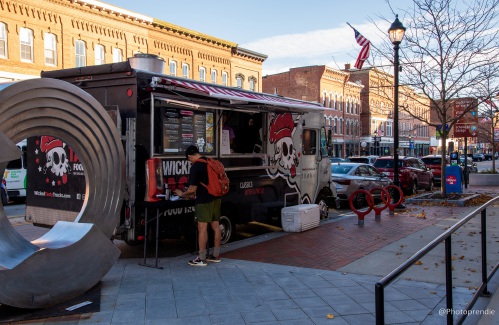
‘We honor your death’ – Arranging services for those who die while homeless in Concord
Sierra Hubbard didn’t know what to do when Christina Laroe died.

‘I want this space to be community’: Witchlight Oracle Apothecary prioritizes connections and spirituality
Abby Rollins has always had an “otherworldly knowing,” one she denied for many years.
Most Read
 ‘New Hampshire is just going to embarrass itself’: Former Child Advocate warns against proposed office cuts
‘New Hampshire is just going to embarrass itself’: Former Child Advocate warns against proposed office cuts
 Two of five Grappone auto franchises to be sold as part of family transition
Two of five Grappone auto franchises to be sold as part of family transition
 ‘Erosion of civil public discourse’ – Concord mayor makes plea for more civility
‘Erosion of civil public discourse’ – Concord mayor makes plea for more civility
 GOP lawmaker wasn’t fired over transgender bathroom comments, business owner says
GOP lawmaker wasn’t fired over transgender bathroom comments, business owner says
 ‘A large chunk of change’: Feathered Friend Brewing disputes tariff on Canadian import
‘A large chunk of change’: Feathered Friend Brewing disputes tariff on Canadian import
 ‘It's like slow genocide’: Crowd rallies against proposed Medicaid cuts
‘It's like slow genocide’: Crowd rallies against proposed Medicaid cuts
Editors Picks
 The Monitor’s guide to the New Hampshire legislature
The Monitor’s guide to the New Hampshire legislature
 Texas veteran joined his sister in NH, hoping to find housing. He died while homeless less than a year later
Texas veteran joined his sister in NH, hoping to find housing. He died while homeless less than a year later
 Sunshine Week: Searchable database of what Concord city employees were paid in 2024
Sunshine Week: Searchable database of what Concord city employees were paid in 2024
 Immigrants in New Hampshire face uncertainty as temporary protections expire soon
Immigrants in New Hampshire face uncertainty as temporary protections expire soon
Sports

High schools: Wednesday’s lacrosse, baseball, softball and tennis results
Bow 13, John Stark 1
 NHTI Delta Dental 5K road race has largest turnout since before pandemic
NHTI Delta Dental 5K road race has largest turnout since before pandemic
Opinion

Opinion: The uniqueness of American imperialism
Jonathan P. Baird lives in Wilmot.
 Opinion: The Declaration of Independence is the antidote to Project 2025
Opinion: The Declaration of Independence is the antidote to Project 2025
 Opinion: Teaching law while the rule of law crumbles
Opinion: Teaching law while the rule of law crumbles
 Opinion: Black sites are us
Opinion: Black sites are us
 Opinion: An attack on the legal profession is an attack on us all
Opinion: An attack on the legal profession is an attack on us all

Your Daily Puzzles

An approachable redesign to a classic. Explore our "hints."

A quick daily flip. Finally, someone cracked the code on digital jigsaw puzzles.

Chess but with chaos: Every day is a unique, wacky board.

Word search but as a strategy game. Clearing the board feels really good.

Align the letters in just the right way to spell a word. And then more words.
Politics

‘A wild accusation’: House votes to nix Child Advocate after Rep. suggests legislative interference
Rosemarie Rung thinks of Elijah Lewis often.
 Sununu decides he won’t run for Senate despite praise from Trump
Sununu decides he won’t run for Senate despite praise from Trump
Arts & Life

‘A vibrant community’: First Fridays kick off in May
As Concord gears up for a packed summer of outdoor events, First Fridays kick off at the start of May, bringing fun for people of all ages.
 Pembroke City Limits to hold screening, Q&A for documentary “It’s Criminal”
Pembroke City Limits to hold screening, Q&A for documentary “It’s Criminal”
Obituaries
 Patricia Ann Wilcox
Patricia Ann Wilcox
Epsom, NH - Patricia Ann Wilcox, 79, of Epsom, passed away unexpectedly at her home on Friday, April 18, 2025. She was born on August 8, 1945, in Throop, PA, daughter of the late James and Sandra (Oshetski) McCooey. Patricia receiv... remainder of obit for Patricia Ann Wilcox
 Paul H. Wunderlich
Paul H. Wunderlich
Contoocook, NH - Paul H. Wunderlich, 87, of Contoocook, NH, passed peacefully on Thursday, February 20, 2025, at Epsom Healthcare Center. Paul was born on February 22, 1937, to the late Frank H. Wunderlich and Evelyn V. (Chelles) in We... remainder of obit for Paul H. Wunderlich
 Herbert Yeaton Jr.
Herbert Yeaton Jr.
Herbert Yeaton, Jr. Epsom, NH - Herbert I. Yeaton, Jr., 80, of Epsom, passed away on Wednesday, April 23, 2025 at the Granite VNA Hospice House following a period of declining health. He was born on July 5, 1944 in Plymouth, NH, son of ... remainder of obit for Herbert Yeaton Jr.
 Doris Eugenie Desfosses
Doris Eugenie Desfosses
Weare, NH - Doris Eugenie Desfosses departed peacefully on Wednesday afternoon, April 16, 2025, to be reunited with her one and only true love Robert Bertrand Desfosses. Doris was born June 25, 1933 in Goffstown N.H., to Mabel and Leo ... remainder of obit for Doris Eugenie Desfosses


 Rehabilitation, parole services at risk under proposed budget cuts, prison commissioner warns
Rehabilitation, parole services at risk under proposed budget cuts, prison commissioner warns
 Concord’s Ryan Doherty leads UAlbany lacrosse in sophomore season
Concord’s Ryan Doherty leads UAlbany lacrosse in sophomore season
 Lawyer: ICE is reversing termination of legal status for international students around US
Lawyer: ICE is reversing termination of legal status for international students around US
 State House to showcase artifacts commemorating 50th anniversary of the Vietnam War’s end
State House to showcase artifacts commemorating 50th anniversary of the Vietnam War’s end
 April showers bring cross-country dust instead of flowers to New England via ‘dirty rain’
April showers bring cross-country dust instead of flowers to New England via ‘dirty rain’
 On the trail: 2028 race gets underway in NH
On the trail: 2028 race gets underway in NH
 Community Players to present “Our Town” at Concord City Auditorium
Community Players to present “Our Town” at Concord City Auditorium
 High schools: Concord baseball wins big, more results from Thursday
High schools: Concord baseball wins big, more results from Thursday

 High schools: Kearsarge boys’ tennis extends win streak, holds on to first place; plus Tuesday’s girls’ tennis, track, baseball and softball results
High schools: Kearsarge boys’ tennis extends win streak, holds on to first place; plus Tuesday’s girls’ tennis, track, baseball and softball results Girls’ lacrosse: Hopkinton pulls off comeback against Bow and earns first victory, 14-8
Girls’ lacrosse: Hopkinton pulls off comeback against Bow and earns first victory, 14-8 High schools: Lovett’s 2 HR leads Coe-Brown softball over Oyster River in championship rematch, plus Monday’s area results
High schools: Lovett’s 2 HR leads Coe-Brown softball over Oyster River in championship rematch, plus Monday’s area results Town elections offer preview of citizenship voting rules being considered nationwide
Town elections offer preview of citizenship voting rules being considered nationwide Medical aid in dying, education funding, transgender issues: What to look for in the State House this week
Medical aid in dying, education funding, transgender issues: What to look for in the State House this week On the Trail: Shaheen’s retirement sparks a competitive NH Senate race
On the Trail: Shaheen’s retirement sparks a competitive NH Senate race Creating community: ice-cream making, sing-alongs, shared gardens and more at Peabody Place in Franklin
Creating community: ice-cream making, sing-alongs, shared gardens and more at Peabody Place in Franklin Hopkinton art gallery features wood and mixed media artists in new collaborative exhibit
Hopkinton art gallery features wood and mixed media artists in new collaborative exhibit  Book review: “Everything Is Tuberculosis: The History and Persistence of Our Deadliest Infection”
Book review: “Everything Is Tuberculosis: The History and Persistence of Our Deadliest Infection”
